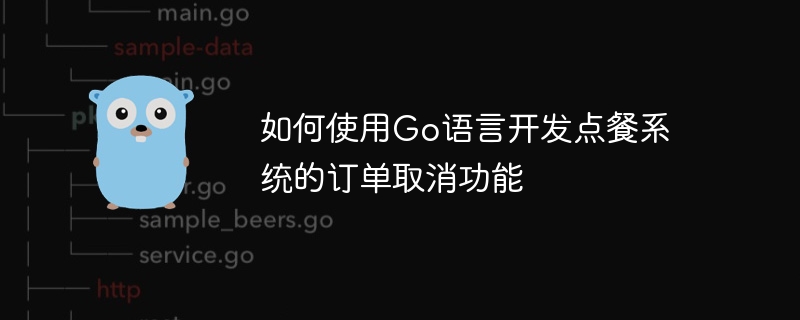

As the takeout market continues to expand, the demand for ordering systems has increased dramatically. Among them, the order system is an essential part of the ordering system. The order system includes many functions, such as ordering, payment, delivery, etc. However, in actual development, we often encounter situations where users cancel orders for various reasons. So, how to use Go language to develop the order cancellation function of the ordering system?
In this article, we will implement the order cancellation function through the following steps:
In the order system, we An order form needs to be designed. In this table, we need to include various information about the order, such as order number, user ID, merchant ID, order status, order amount, etc. In addition, we also need to design an order cancellation table to store canceled order information. When canceling an order, we need to store the canceled order information in the cancellation table and modify the original order status to "Cancelled".
The following is the data model of the order table and order cancellation table:
//Order information table
type Order struct {
OrderID string `json:"order_id"` UserID string `json:"user_id"` MerchantID string `json:"merchant_id"` Amount float32 `json:"amount"` Status int `json:"status"` //订单状态:1:未支付 2:已支付 3:已完成 4:已取消 CreatedAt time.Time `json:"created_at"` UpdatedAt time.Time `json:"updated_at"`
}
//Order Cancellation table
type OrderCancel struct {
OrderID string `json:"order_id"` UserID string `json:"user_id"` Reason string `json:"reason"` //取消原因 CreatedAt time.Time `json:"created_at"`
}
When implementing the API interface for order cancellation, We need to first check whether the status of the order is "Unpaid" or "Paid". If the order status is "Completed" or "Cancelled", cancellation is not possible. If the order status is "Unpaid" or "Paid", you can cancel it. Cancellation of an order needs to be completed in two steps. First, we need to modify the order status to "Cancelled" and then store the canceled order information into the order cancellation table.
The following is the API interface code for order cancellation:
func CancelOrder(c *gin.Context) {
orderID := c.Param("order_id")
reason := c.PostForm("reason")
//查询订单状态
orderDetail, err := db.GetOrderDetail(orderID)
if err != nil {
c.JSON(http.StatusBadRequest, gin.H{"error": "订单不存在"})
return
}
if orderDetail.Status != 1 && orderDetail.Status != 2 {
c.JSON(http.StatusBadRequest, gin.H{"error": "订单状态无法取消"})
return
}
//取消订单操作
tx := db.GetDB().Begin()
//将订单状态修改为取消
err = tx.Model(&db.Order{}).Where("order_id = ?", orderID).Update("status", 4).Error
if err != nil {
tx.Rollback()
c.JSON(http.StatusInternalServerError, gin.H{"error": "取消订单失败"})
return
}
//将取消订单信息存储到订单取消表中
orderCancel := &db.OrderCancel{
OrderID: orderID,
UserID: orderDetail.UserID,
Reason: reason,
}
err = tx.Create(orderCancel).Error
if err != nil {
tx.Rollback()
c.JSON(http.StatusInternalServerError, gin.H{"error": "取消订单失败"})
return
}
tx.Commit()
c.JSON(http.StatusOK, gin.H{"message": "订单取消成功"})}
In order to verify whether the order cancellation function is implemented, we can create a simple front-end page for order cancellation. On this page, we need to enter the order number and cancellation reason, and then click the "Cancel Order" button. If the order is canceled successfully, the message "Order Cancelled Successfully" will be displayed. If the order status cannot be canceled or the order cancellation fails, an appropriate error message will be displayed.
The following is a sample code for the front-end page:
<title>取消订单</title>
<form action="/cancel_order" method="POST">
<p>订单号:<input type="text" name="order_id"></p>
<p>取消原因:<input type="text" name="reason"></p>
<p><input type="submit" value="取消订单"></p>
</form>The above is the detailed content of How to use Go language to develop the order cancellation function of the ordering system. For more information, please follow other related articles on the PHP Chinese website!
 Usage of Type keyword in Go
Usage of Type keyword in Go
 How to implement linked list in go
How to implement linked list in go
 What are the Go language programming software?
What are the Go language programming software?
 How to learn go language from 0 basics
How to learn go language from 0 basics
 What are the methods to implement operator overloading in Go language?
What are the methods to implement operator overloading in Go language?
 What are the operators in Go language?
What are the operators in Go language?
 What does a file extension usually mean?
What does a file extension usually mean?
 How to align text boxes in html
How to align text boxes in html
 How to solve the invalid mysql identifier error
How to solve the invalid mysql identifier error




